Well, we made it to Berlingas.
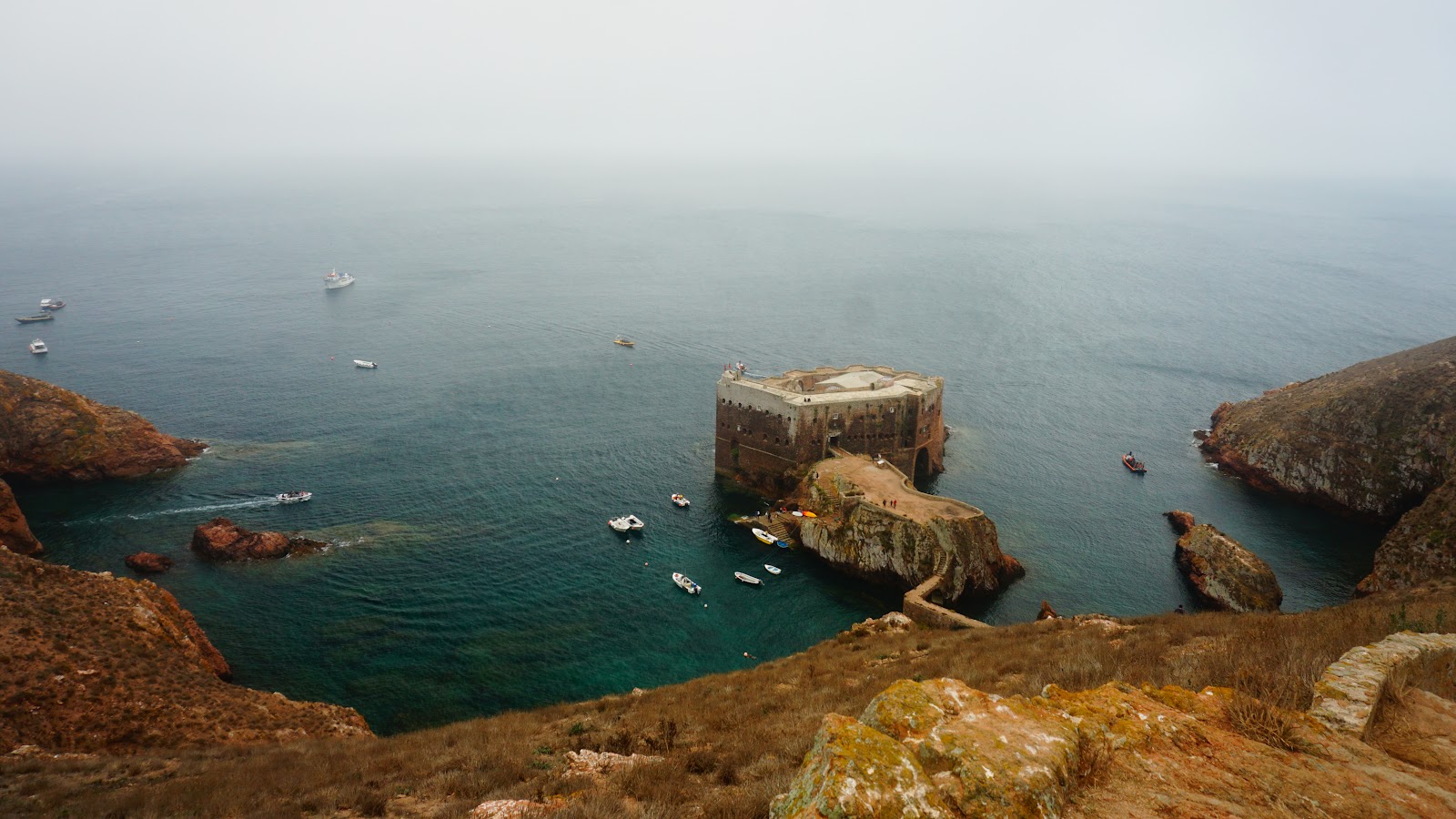 |
| Fort Joao Batiste from above |
So, we took the whole "Get permit to step a foot on the island or ELSE!" thing very seriously, primarily because during tourism, even the low-probability risk associated with a high penalty is highly undesirable. At the same time both of us had our suspicions that the "PERMIT!!!" was actually not going to be checked (see our experience with the International Driver's Permit". The basic modus operandi appears to be to declare that SOMETHING IS NEEDED, but never bother checking for it. This works in parking lots (no one really checks how much we paid for parking vs. how long we stayed on the lot), and this works with all other things. So, yeah, we paid for those permits. Even worse, we wasted about two hours on it yesterday, two hours we could have used for other things. And it did not matter at the end. Portuguese bureaucracy can cry wolf only so many times. I also suspect that those "Immigration Report Forms" we are receiving from Airbnb are also pretty pro forma as well.
But we digress. Woke up in the morning to a somewhat wet day. Not really raining, but very saturated air, that on occasions turns into drizzle. Just the time to visit an island, eh? Drove to the Paniche Marina - a nice 30 minute drive from our place in Obidos - we chose a bigger highway over one of those "national roads" - not necessarily to get there faster, but to avoid early morning stress of driving through tiny villages on tiny streets (yesterday driving around Caldos da Rainhia to the parking lot was an interesting experience).
Peniche met us with similar weather. No sun, a slight wind, and a bit of a drizzle. We talked to the person at the ticket booth about the entire "Berlingas Permit" thing ("You may need it if they decide to check at the Berlingas port. But they don't check"), buying the boat excursion on the island ("There is a guy in yellow shirt on the boat, give him some money"), and got our paper tickets ("What's your name?" - I bet we could be on any boat on a given day by simply saying "Joao Silva" in response), and went to the boat, where we were second group in line to board.
 |
| Our boat |
The boat has an upper deck, open to the winds, and a lower deck, that is closed. We chose to sit at the top for the trip to the island, despite the weather. The trip itself took about 50 minutes. The weather did not really improve much, visibility was pretty crappy through the mist, and on occasions we got bouts of storm and waves. We bought tickets from the guy in yellow shirt, for a ride at noon. Eventually, a land mass finally materialized from behind the mist and we approached the Berlengas Archipelago.
 |
| Approaching Berlengas |
For the sake of simplicity, here is a map of the island, with the main points of interest that we visited either on foot or by boat marked up.
We arrived to the port around 11am, so had about an hour before our boat trip was scheduled. Berlingas is essentially a huge rock, with a pretty high elevation - according to wikipedia, Berlinga Grande, the island we were on has 88 meter elevation - does not look like much, but it is essentially straight up the hill from the port.
Right above the port is a small clump of houses called Barrio dos Pescadores - not certain if any pescadores really a left there - the houses appeared to be lodging. The village has a cafe and a restaurant. First order of business upon disembarkation (and we got lucky to be the first ones from the boat who made it there before the lines formed) was to get coffee at the restaurant. The lady at the counter gave us two coffees, Olga decided to take both - as she wanted to get warmer.
 |
| Disembarked! |
Besides the village, the island has two major man-made structures: a lighthouse situated, presumably at the highest point on the island, and Fort Joao Batiso built in the 17th century to help defend the coastline of Portugal. With about 40 minutes left of our hour wait for the boat tour, we went up the main road from the village towards the lighthouse. Despite the scary-looking heights, that road is paved and has a nice grade, so the hike itself is about 10-12 minutes.
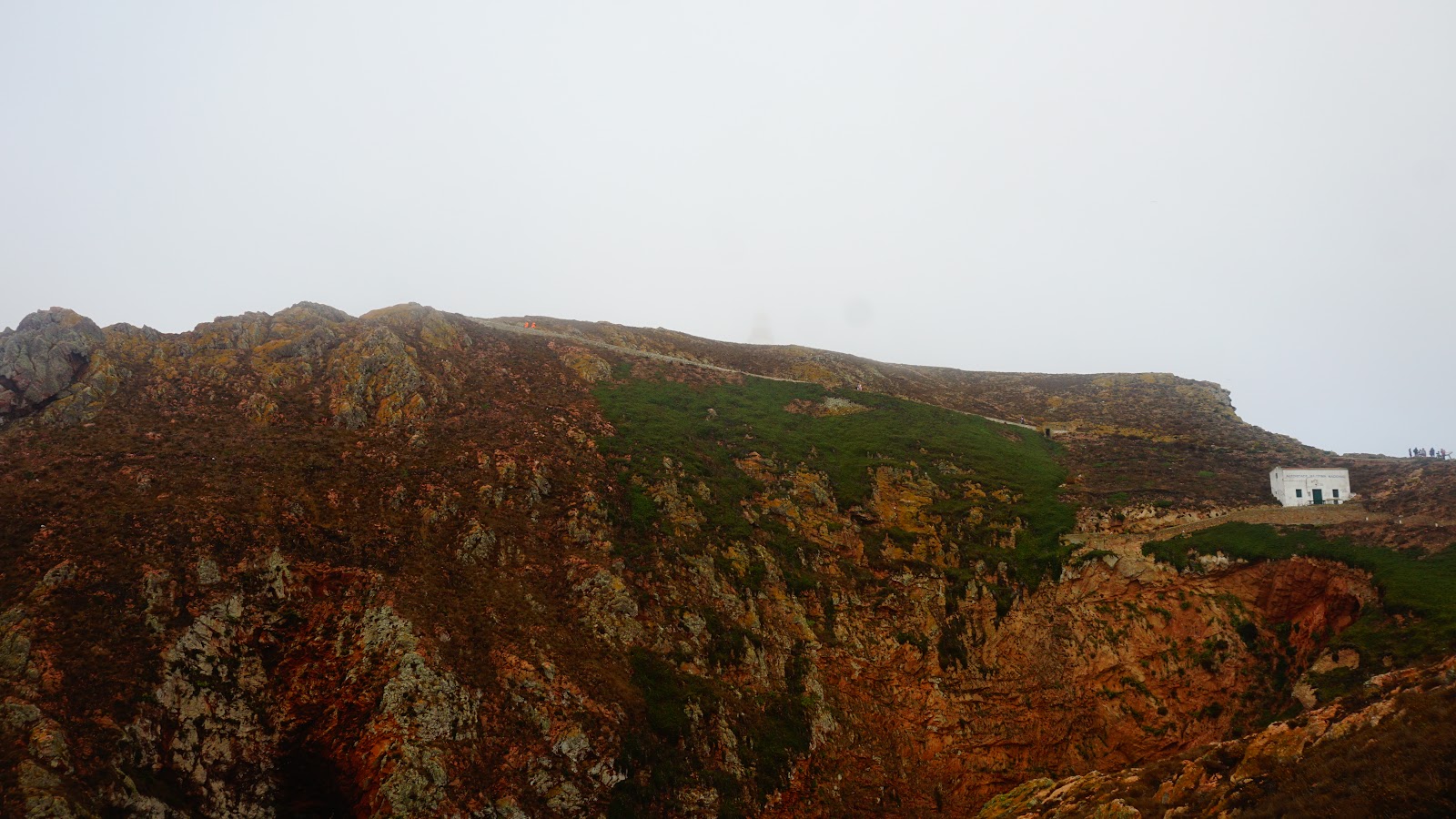 |
| Trail up towards the lighthouse. The lighthouse is barely visible from behind the mist. Pictured is the top part of the trail. |
About the midpoint of the hike to the lighthouse we came to the narrowest part of the island, where the port haven on one end is almost met by a pretty deep inlet on the other.
 |
Narrowest part of the island, with the inlet, view from the top.
|
From there, we went up a bit more to get some picturesque (even in the somewhat inclement weather we were experiencing) views of the fishing village and the port, before finally coming up to the lighthouse itself. Somewhat unfortunately (I did not read ahead of it, and assumed that the lighthouse was explorable), the lighthouse appears to be a working facility of the Portuguese Army, so it was closed to any visitors. We took some pictures in front of it, and went back towards the port to catch our boat excursion.
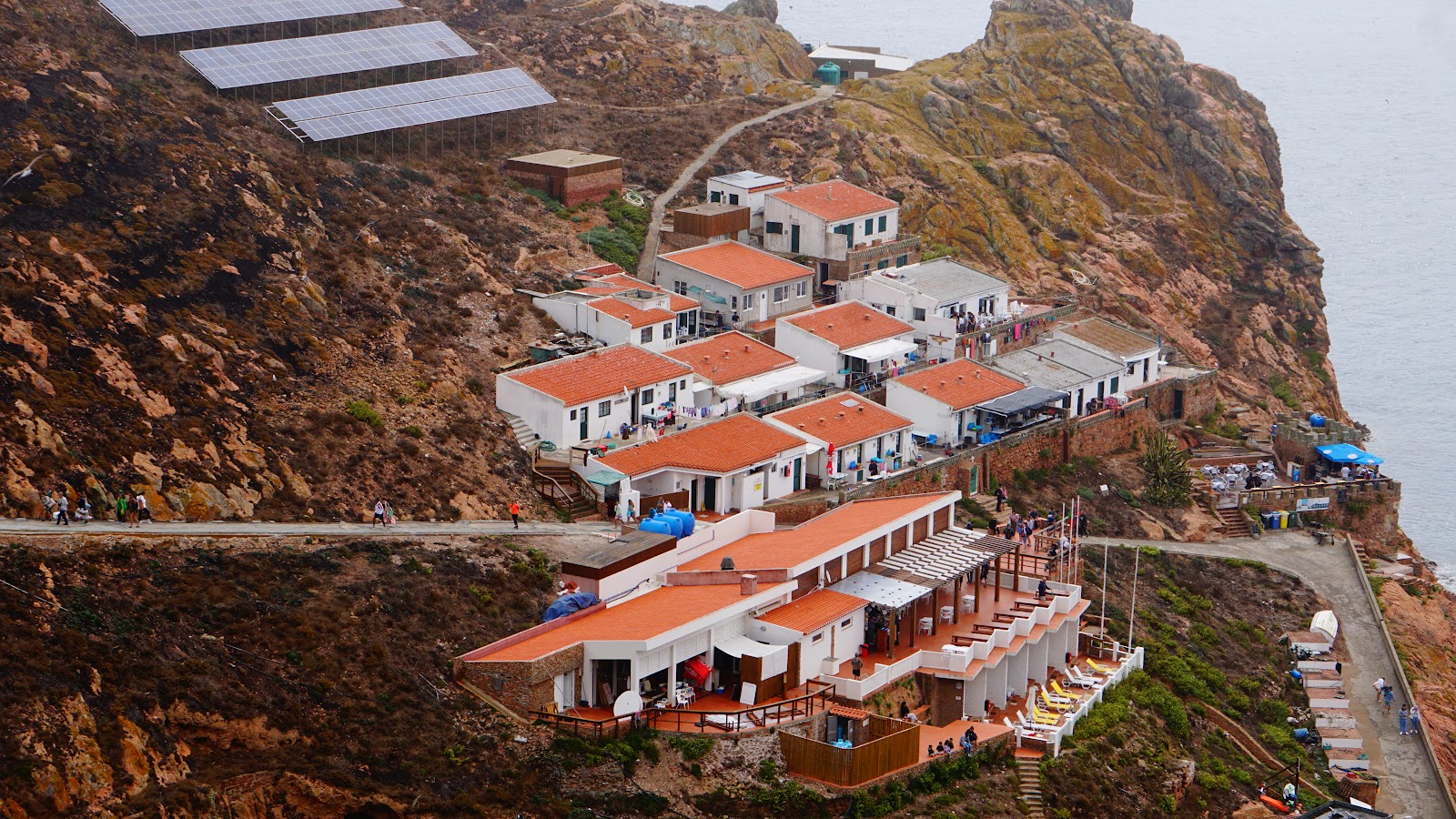 |
| Closeup of Barrio dos Pescaderos. |
 |
| My "I was there" picture in front of the lighthouse, barely visible at the moment. |
With the small bit of time we had before the boat arrived, we walked a short walkway from the pier towards a small cave separating he pier from the island's beach. The water in the cave was transparent and I spotted several fish there. Later we saw significantly bigger schools of fish pretty much everywhere around the island - with the very clear water, they were easy to spot and track.
 |
| Olga exploring the cave |
We then finally boarded a small (9 passengers) boat with a piece of glass floor and took a tour around a part of the island. We went from the pier through a narrow gap between the island and a free-standing rock towards the location of the fort, circumnavigated the fort, and went to one of the natural wonders of the island, the so called Furado Grande - a large and long tunnel under the island that lead into a small bay on the south side. That bay had another furado (tunnel) on the other side of it, but much smaller and not navigable.
 |
| Passing between the rocks. |
 |
| Fort Joao Batiste as seen from the boat. |
 |
| Entering Furada Grande (I took a video of us passing through, so this is the only actual picture I have) |
A small curiosity is that in addition to two water tunnels linking parts of the island together, there is also a Furada Seco, a small passage (the guide called it a "belly button") that is located right above the Furada Grande.
 |
| The south entrance to Furada Grande, and the Furada Seco right above it (the dark hole in the center of the photo). |
We then sailed around the southern tip of the island, a structure very aptly named Elephant Head.
 |
| The best picture of Elephant Head - complete with an actual eye, I could get from the boat (all the people on the other side of the boat were in front of the camera). |
On the way back, the boat visited a cave they called the dream cave - essentially one of the many (but somewhat bigger) indentation in the island's coastline - which, btw, is extremely eroded - with plenty of caves and grottos throughout. After that, the boat dropped us all off at the fort, thus saving us the need to hike there from the pier.
 |
| The Dream Cave. |
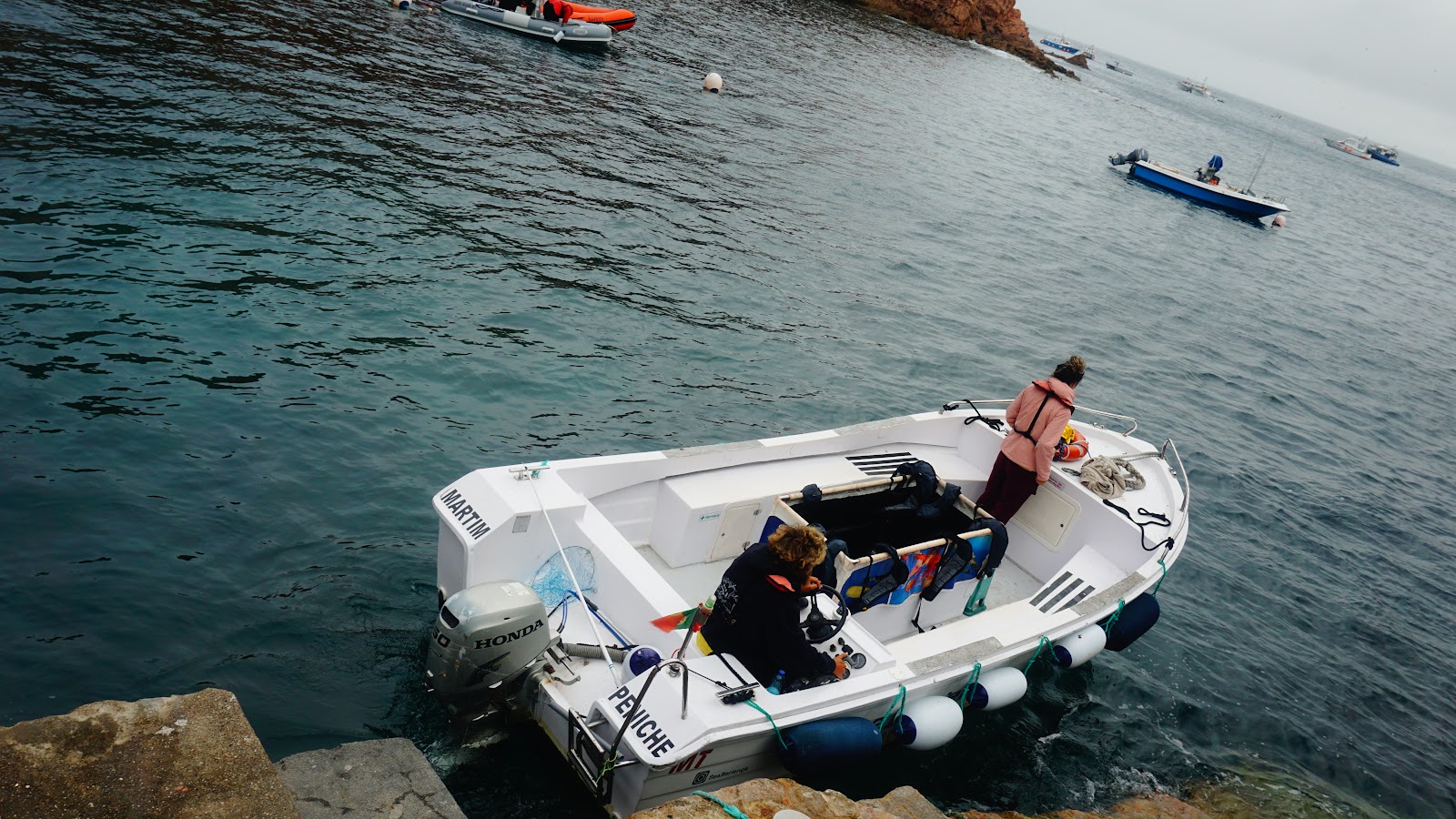 |
| Our boat, having dropped us all at the fort, is about to leave. |
The overall ride took about 20 minutes and cost us 9 Euro per person. At some point we tried to do the math (one trip each 30 mins, 9 people in the boat, 81 euro per trip, two people in the boat, at least another two, possibly three on land - selling tickets and managing the embarkation), we are looking at something like ~1300 Euro per day revenue off the boat alone (the company also rents kayaks, so their actual revenue should be higher). Not certain what the upkeep costs and labor costs are, but it seems like a reasonably low margin affair all things considered for me to begrudge them the experience. Plus, I would gladly pay the same amount just for taxi service to the fort alone (which this boat essentially performs), without the tour part. I have a few more kind words to say about the business side of the island below.
 |
| Inside the fort. |
At the fort, I got the next surprise of the day. I expected old untouched ruins with wondering tourists. Instead, the fort is a fully operating facility, that charges 1 euro to enter (the big advertised attraction is not the Fort's history, but the ability to visit the bathrooms). Olga gave the guy a five-euro bill, got back 2.50, went back to the guy who very nonchalantly returned her the missing 50 cents. The entire exchange was almost hilarious (the stories of getting wrong change are kind of the lore of Soviet Union, so this made us cackle a bit), but I kind of wonder how much per day the guy makes on his "honest mistakes" with the change. Given the prices, probably enough for a few beers.
The fort, interestingly enough does have a history that includes battles, naval assaults, capture, civil war, pirates, and guerilla raids, which was also a bit of a surprise - often time my experience with well-preserved monuments of this kinds is "and it never saw any action". Not the case here, very much not the case. It was decommissioned about 100 years ago, after which it changed hands a few times, was abandoned for a while, was turned into a 4-star hotel in the 1950s, went out of service in 1970s after the Revolution (because apparently this was the kind of place rich Salazar supporters would visit and only them - sorta like Mar-E-Lago these days), and then eventually went into the safekeeping of Association of Friends of Berlingas, that essentially operates as a club - you pay your annual dues, and you get to lodge and hold events in the facility. There are room embedded in the walls of the fort (you can kind of see the steps to one of them in the picture above), there are also a few more rooms in the fort building itself - by the looks of the "local" crowd inside the fort, on the day of our visit these rooms were mostly occupied by surfers and divers. There is also an event venue in the fort courtyard that served spaghetti to the club members when we were there. Finally, the courtyard would not be complete without a small cafe.
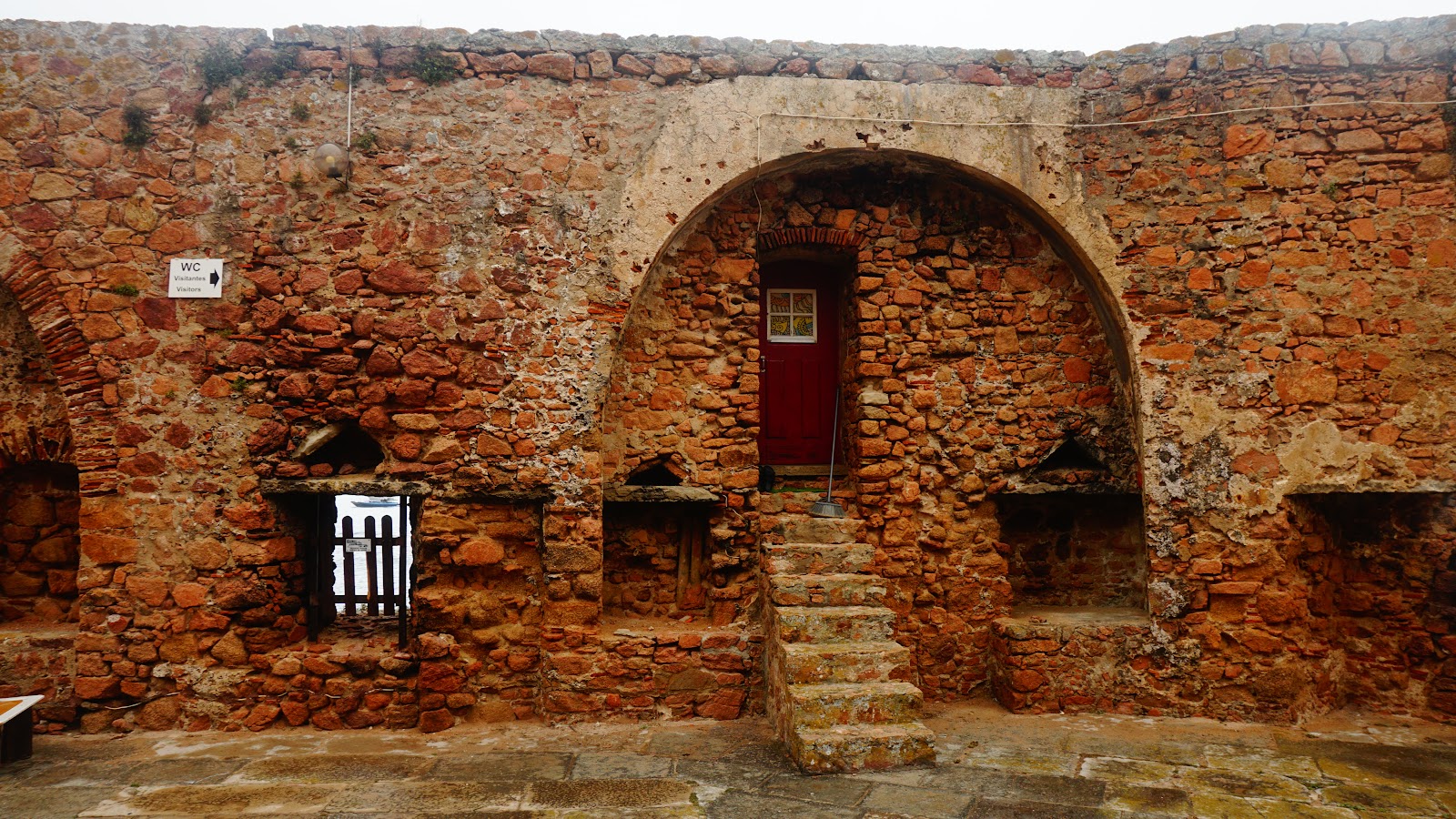 |
| A room in the wall. |
From the courtyard we went to the terrace and got some nice views of the land and see around the fort.
 |
| Fort Joao Batiste - view from the top. |
After a visit to the terrace/roof, went back to the courtyard, found a table, and decided to have a small picnic. I went to the cafe and bought to glasses of sangria that cost me a total of 3 euros. The cafe had a limited selection of food and drink (the most sophisticated dish was a hot dog, I think), but I was surprised at how low the prices were (should have taken the pic of the menu board - my bad). Basically, when we visit hard-to-access locations (e.g., tops of the mountains, islands, etc...) I expect significant markups for whatever food that is available there - it was most certainly the case in Switzerland (which, all by itself is expensive, but also marked up everything on top of
Jungfraujoch, and is definitely the case in various places in the States (last time we experienced it on our funicular ride at Palm Springs). We totally expect to significantly overpay for food and drinks in such places. Around Berlengas, a glass of sangria is 1.5 euro, a cup of coffee is 1.5 euro, and everything else was just as reasonably priced. Of course they add markup to chips etc.., but heck, a large bag of chips is 3 euro. Now one thing I noticed about Berlengas, is that close to 80% of visitors spoke Portuguese. We heard some Spanish, French, English (mostly American) around the island, but no Russian, for example (which we heard plenty of in Obidos and Caldos da Rainha). So, I suspect that the lack of significant markup on food and drinks on the island is at least in part because they can only do what the market would bear and the market is mostly national, not foreign tourists. Their real competition is not with other establishments on the island, but with picnic baskets that people bring with them - and
almost everyone on a day trip brought food with them. So, perhaps that's the answer. Either way, a really nice feature of Portugal - not only food is inexpensive, but even in the situations where there is plenty of opportunity for markups of food, goods and services, they are not taken quite the same way they would be elsewhere (I am looking at
you, Switzerland, and
you: USA and Canada).
Anyway, the sangrias were great and refreshing and went well with our own picnic of bread, sausage, cheese and bacon.
 |
| Humble but tasty lunch at a historic fort. |
After lunch, it was time to head back towards the village. This, first and foremost, required crossing over from the islet on which the fort was built, to the main island walking over a pretty narrow (and in the fine tradition of Portugal - without any sign of rails) bridge, and then taking a steep climb up those 88 meters of height.
 |
| The bridge to cross. |
 |
| And the hill to climb. |
Crossing the bridge, again saw plenty of fish.
 |
| These are bigger than sardines, but we are not 100% what they are. |
Climbing up, got to take in some really breathtaking views, and took a lot of pictures. This also helped with giving me a pause to catch breath (a mistake I made during a
climb in Iceland, that I will not repeat again).
 |
| One of my favorite pictures of the fort. Unfortunately, features Olga's elbow, which needs to be cut in postproduction. |
 |
| More fort, higher elevation. |
For all the steepness of the path - and the unevenness of the steps- some steps had their own steps to help climb them - it was actually really well constructed and maintained, and made he climb not as hard an exercise as I feared. Now, climbing down this path is probably a bit more of a challenge, fortunately, we avoided it (so those 9 euros per person paid off at the end).
 |
| Even higher elevation. |
 |
| Getting close to the top of the climb. |
At the top, there is a trail running from the village to the southern end of the island. Somethat unfortunately, perhaps, we decided not the venture south (at the end it turned out that we would have had plenty of time), instead, choosing to go back. The scenery at the top of the island is pretty much dominated by the lighthouse. With a bit more visibility at the top, you can really see it.
 |
| Approaching the lighthouse from the south. |
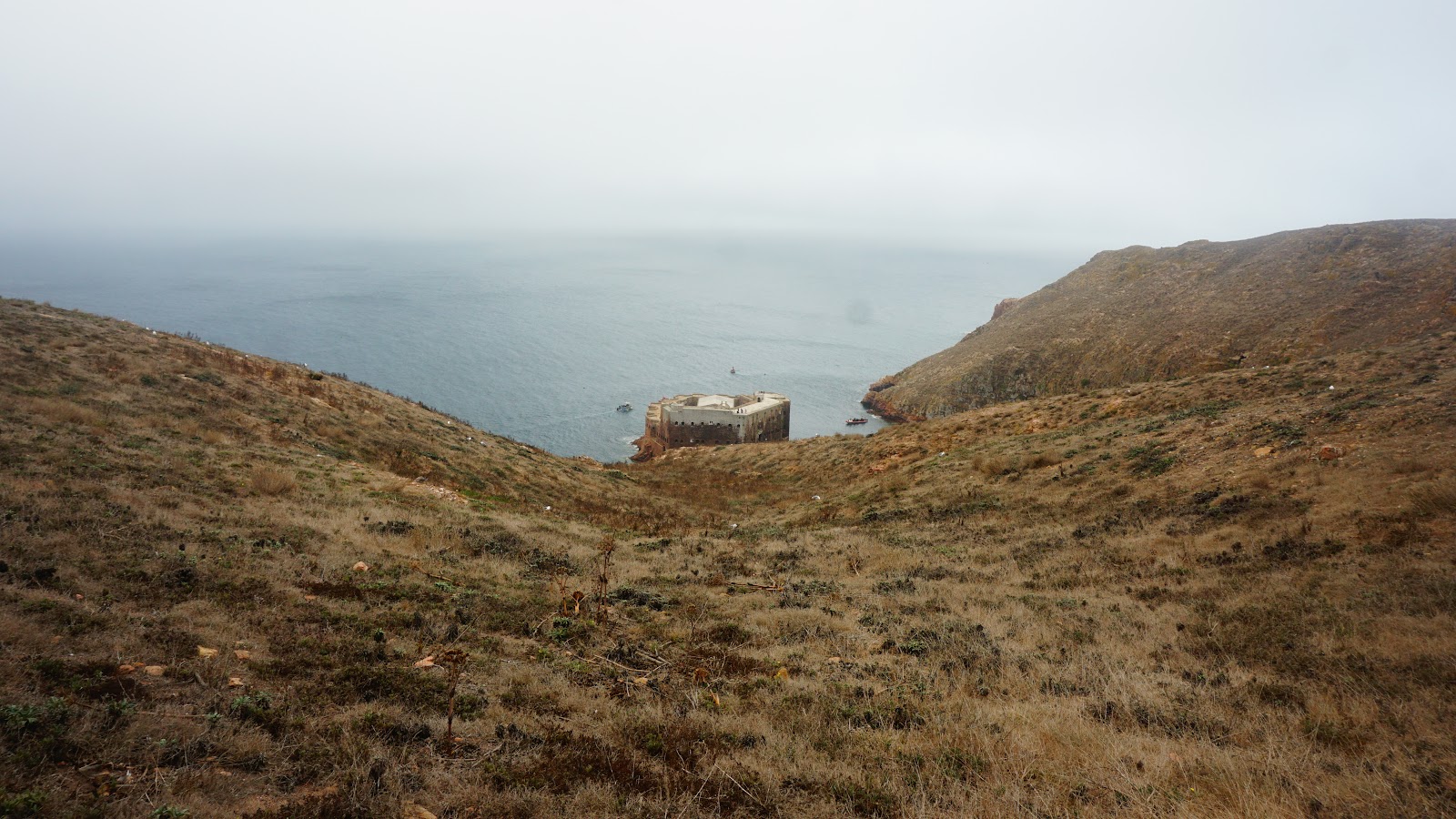 |
| One last look at the fort. |
There was no one at the lighthouse we were comfortable asking to take a picture of the both of us (a few groups were in the middle of their picnics, we did not want to interrupt them), so we opted for selfies instead.
 |
| Selfie with the lighthouse. |
From there we repeated our earlier descent into the village, but right before entering it, detoured to a trail to two locations called Merleu and Buzinas - essentially two really nice vista points with east, and north-east views.
 |
| Merleu. |
The hike itself is a circle that took us about 35 minutes at a leisurely pace with stops.
 |
| Hiking from Merleu to Buzinas. |
Our main companions along the way were seagulls. They are - if not nesting, then defiintely, inhabiting the cliffside.
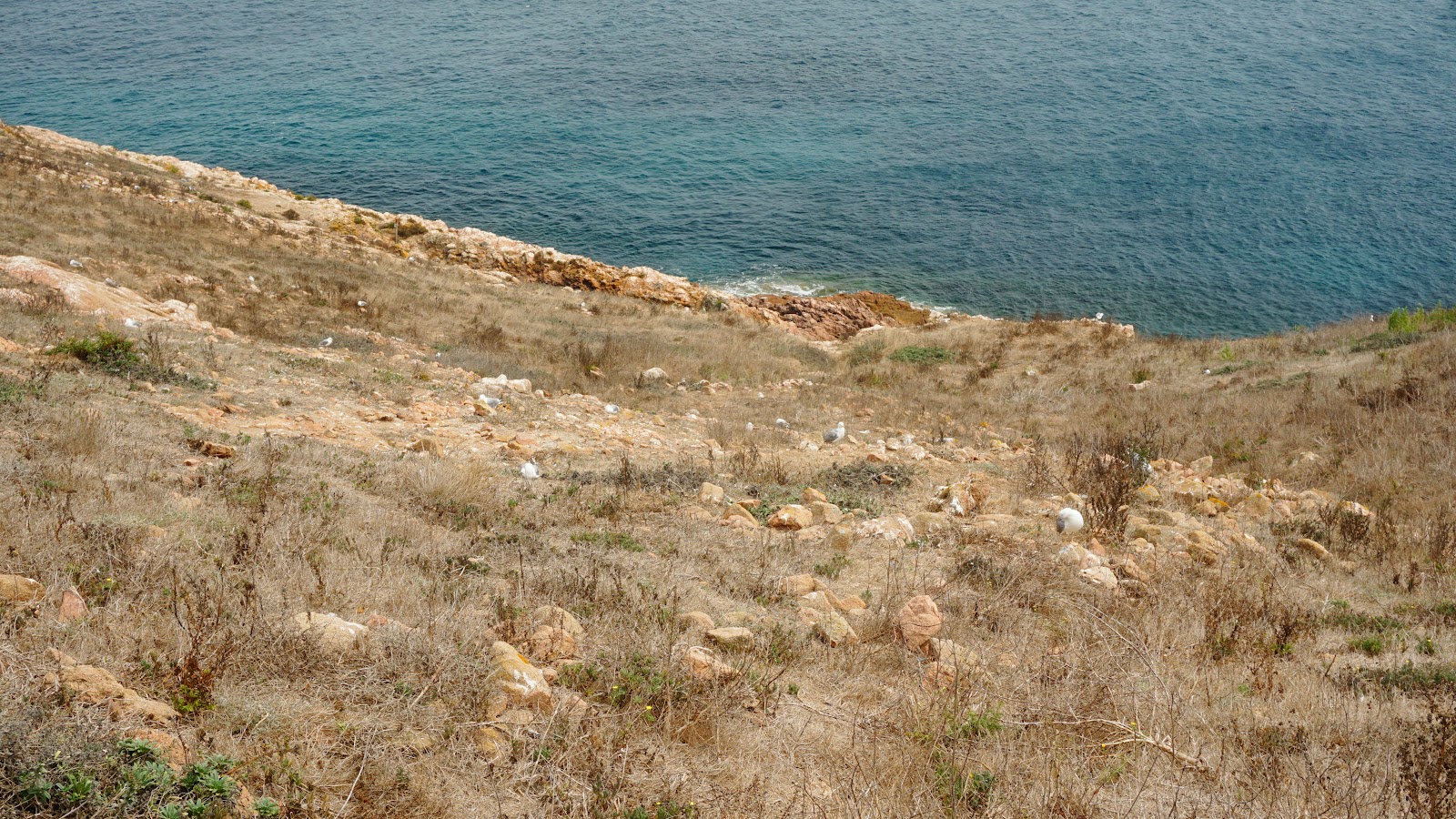 |
| Seagulls. |
This is the more quiet deserted part of the island - very few people take this trail (comparing to the hundreds of people on the trail between the village and the fort). As we approached the northern end of the trail and the island, we got hit by the northern wind which brought with it a lot of ocean mist, threatening to actually soak us for real this time.
 |
| The Buzinas visa point is not the most hospitable. |
After the Buzinas vista point, the trail went up towards the top of he island, and curved back south. Even more seagulls in the area. Olga broke out our binoculars (we tend to take them on our trips, but rarely use, this time, they did see action), and did some birdwatching, eventually spotting a bird she claimed was a gagara.
 |
| Birds watching Olga while Olga birdwatches. |
On the bright side (pun somewhat intended), the northern wind that first brought the mist to fall on us, also seemed to have totally cleared the air around the lighthouse, so when we got up to the top of the plateau, we got treated, finally, to an unobstructed view.
 |
| These two pictures were taken from the same spot only a few minutes apart. |
I changed the lens on the camera and got some closeups of the top of the lighthouse.
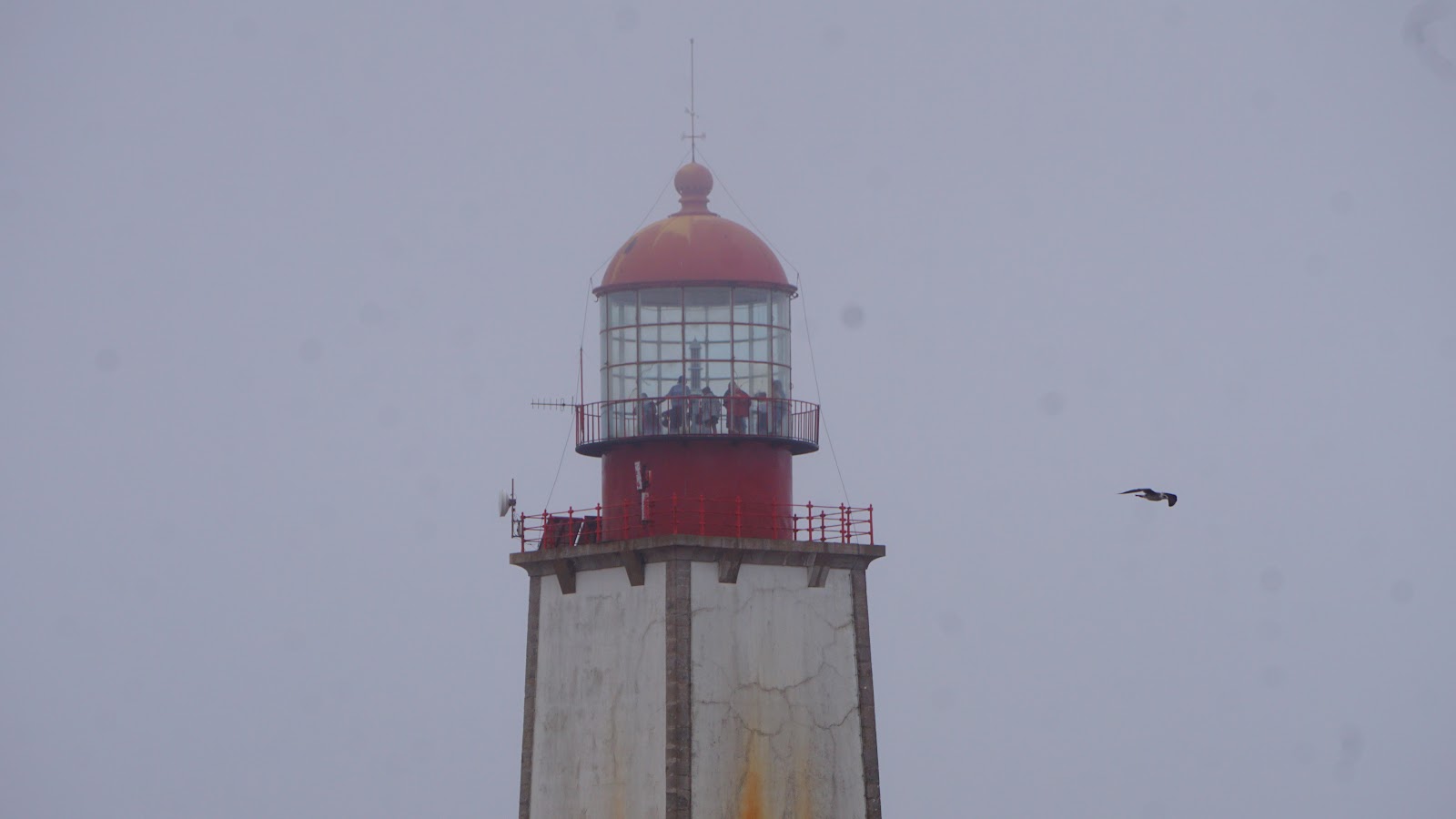 |
| There are some people there! |
Interestingly enough we caught some people there! Olga used her binoculars - which have an even better magnification factor and at some point counted seven people, but they were gone after a short while.
 |
| ...and now, they are (almost) gone! |
We don't know whether this was a public tour, or some private thing, or whether these are the facility staff - we were pretty tired by the time we finished the trail, and decided not to investigate. So the mystery remains, but we have the pictures!
 |
| Finishing the trail. |
The descent from the trail was pretty steep (my personal advice - take the trail counter-clockwise, like we did anyway - as you get much better views
in front of you throughout the trail. But please be aware that the very last part of the loop is a bit of work to descend.)
Went down to the village, and with about an hour before the boat back, somewhat tired, found a table at the restaurant and got a coffee and a sangria.
 |
| Berlingas Island rest be like this. |
Spent some time recouping, then went down to the pier level and took a walkway to the beach, where we spent a few minutes trying the get our hands wet (and getting my feet almost wet instead) and watching the fishes. There were a few people swimming in the water, but overall, it looked cold.
 |
| View from the beach. |
Finally, went back to the pier where a line of people returning on our boat already has formed. The boat came soon enough, we boarded, went downstairs (both because we wanted to, and because all the seats on the top deck were taken by the time we got on-board), and pretty much collapsed on the whole boat ride to Peniche.
Back in Peniche, we decided to take a walk around town. Took some time looking for a restaurant. At 5pm - they already have their menus out, but many are not seating customers (and many are just empty). As a result, instead of waiting for a seafood place to open, we opted for a Turkish doner place and had some nice kebab. (Trying to remember here if we had kebab last time we were in Portugal - this is certainly our main food in Germany and Switzerland, and we've had it in other European countries as well). Same deal - our dishes were like 5 Euro each, comlete with two 1-euro glasses of sangria (this one, unlike the previous two was flat) cost us 12 euros for two people, whereas in Switzerland, a trip to McDonalds was at least 20 (for two, for four it was more like 45).
 |
| Kebab plate. Beware of the orange sauce. It is hot. |
After the meal, we spent about an hour walking the central streets of Peniche. Stopped by a bakery and bought some deserts, which turned out to be really good (for anyone keeping score: 1 tea, 1 coffee, two slices of really tasty cake, and one Pasteis de Peniche - with a nut-based filling, I think - cost us 8.75. Bless, you, Portugal, a similar order in Mountain View, California is easily $20, and can be as high as 35-40 if one is really unlucky with their choice of a bakery).
 |
| Pastries. A walnut caramel mousse cake (top), a walnut honey cake (right) and wrapped pastel de Peniche. |
The bakery was located on what looked like a central square - which also served as a home to at least four other bakeries/ice cream shops (they all do both).
 |
| Peniche's most happening square. "Our" pastry shop is at the ground floor of the tall building at the back. |
From the pastry shop, where we set outside, we glimpsed a nice side street, and went up there.
 |
| A cute side street. |
Walked the streets a bit, circled around, went back towards the port. On our way, passed the historic part of town, with what seemed like the biggest church in town (Olga went in, but they had an active service going, so we did not go inside to look at the church itself.)
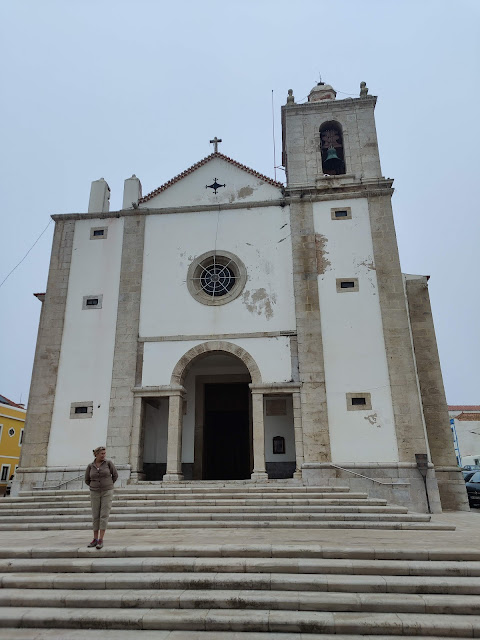 |
| Based on google maps, this is Igresia de Sao Pedro (Church of St. Peter). |
 |
| A house covered in azulejos. |
Portside, we passed by the Peneche fort, which, based on google maps again is the museum of Resistance. Would have been a great place to visit, but unfortunately, we had no way of making it there, and we are unlikely to return to Peniche on this trip.
 |
Museum of Resistance.
|
Got to our car, and started going home, but noticed an open-air market (open past 7pm no less), and took one last stop. At the back of the market, a man was making bifanas. I ordered one. It was good.
 |
| The art of bifana making. |
 |
| The resulting bifana. |
After this, went home and called it a day around 8:30pm. We both were really tired, took some naps before heading out to bed for good.
Alcohol. We did not open any new bottles at home, so I'll just talk about the sangrias a bit. Portuguese sangria are served differently than the Spanish ones (not that we have been to Spain). In Portugal, 90% of the time, the sangrias are served fizzy - from our previous visit - mostly fizzed by 7up (I am not a big fan of 7up, so when we make this style of sangrias back home, I add (diet) ginger ale for a very similar effect). Today, we had three sangrias - two were fizzy, the one at the kebab place was flat. Yesterday, we had one sangria at the pastry shop in Obidos - that one was fizzy, contained some ginja in it, and also had fresh fruit - if not made from scratch, then at least assembled at the pastry shop itself. In all cases, the sangrias were extremely affordable (essentially the same price as a cup of coffee, or less), and despite the wide range of presumed quality (from something carefully made at a relatively fancy coffe-shop, to something poured out directly from a store-bought bottle), all tasted good and were very refreshing. It is hard to destroy a sangria. All four were red. I like white sangrias a bit more, but in general, I am very much pro-any-sangria.
Steps. Google fit and my watch are having an argument. Watch (which was at 0 in the morning) shows 15,967 steps: less than yesterday, but then today significantly more of those steps were actual steps up or down. Fit has already reset, and shows 18,005 steps for Wednesday, and 0 steps as of now. Either way, not bad for the day.
Tomorrow. Planning to visit Batalha Monastery, Leiria (the castle and the town), and, if have time - stop by Fatima in the afternoon. Need to be home by 8pm, sharp, and are likely to leave a bit later, but we'll see how the day goes.







































































